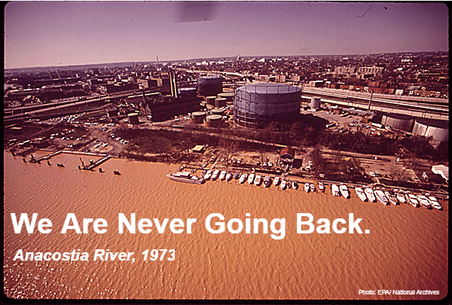 --by Bobby Whitescarver. Note: A different version of this essay was published as an OPED piece distributed by the Bay Journal News Service on October 17, 2017. Read that article here. The Clean Water Act is now 45 years old, born in the U.S. Congress on October 18, 1972. Sometime before that date, the river of my childhood – the Roanoke River in southwestern Virginia – had been declared a fire hazard because of pollution. I learned to water-ski on that river, or rather on one of the manmade lakes along its winding path. It was 1965 and I remember one of those skiing lessons in particular. Dad was the spotter, and his friend George was the driver. I jumped in the water and waited for the handles of the ski rope. When the tips of my skis were up and my butt down, I yelled, “forward!” As the boat began pulling me, I saw banana peels and “floaters” – human waste – drifting past. I was ten years old, and it gave me the heebie-jeebies. “Hit it,” I shouted, now doubly motivated to get up and out of the water. America now has perhaps the best wastewater treatment in the world. . . . All industries and municipalities that discharge pollution into U.S. waters must have permits to do so. They cannot exceed their allocation of pollution. It’s regulation that works. It was not easy getting to this point: there was much gnashing of teeth, whining, litigation, and political feuds. But all “point” sources of pollution (coming out of a pipe) in this country are now regulated and for good reason.
And now we’ve turned our attention to the more complex problem of “non-point” source water pollution, which finds its way into rivers and streams from virtually everywhere. It comes from stormwater runoff from roads, roofs, parking lots, over-fertilized lawns and golf courses, from pesticides, herbicides and malfunctioning septic fields, from bare ground, heavily fertilized crops, over-grazed pastures, livestock waste and all sorts of other human and natural activities. We’ve come a long way since the passage of the Clean Water Act. Before then we occasionally worried about industrial pollution – and we never spoke of stormwater management, nutrient management, riparian buffers, livestock exclusion from streams, no-till farming, conservation easements, rain gardens and any other best management practices that today add up to greatly improved water quality. The Clean Water Act gave us a roadmap for responsible land use, and today our streams, rivers, lakes, and estuaries are measurably cleaner than they were in the 1960s. This despite the fact that we’ve added over 100 million people to our population! The Chesapeake Watershed alone is home to more than 18 million people, and that number is expected to reach 20 million by 2030. Given those disadvantages, the progress is pretty impressive. We’ve done this by using the law, sound science, strong partnerships, outdoor education, advocacy, incentives, consequences for blatant polluters, and litigation – all enabled by the Clean Water Act and driven by people and organizations that believe clean water is good for all. We are moving forward for cleaner water and we can celebrate major achievements: a freshwater stream once again supporting Brook Trout, or a wastewater treatment plant discharging cleaner water than the stream it dumps into. The Chesapeake Bay, America’s largest estuary, had no dead zones last year – the first time since the sixties. The benefits of clean water are immeasurable: more recreation, more seafood, healthier livestock and a stronger economy. As they say, a high tide raises all ships. But there are now torpedoes of ignorance, greed, and science denial in the water – launched by the Trump administration, and aimed at the fundamental environmental laws that have gotten us so far. They want to “water down” the definition of “Waters of the United States” so that polluters can get away with it and thereby increase their profit margins. They want to zero-out funding for the Chesapeake Bay Program and for clean water initiatives everywhere and seek to discredit scientists and hide or destroy their research. I say damn the torpedoes, full speed ahead! We – and every last one of us – need to tell our representatives in Washington that clean water is vital to our future as a country, that they must continue to fully fund clean water initiatives. We simply cannot afford to weaken the Clean Water Act; we cannot afford to go back to the filthy water of the 1960s. Robert Whitescarver is a farmer, educator and conservationist. Visit his website HERE.
0 Comments
Leave a Reply. |
When we see land as a community to which we belong, we may begin to use it with love and respect.... Conservation, viewed in its entirety, is the slow and laborious unfolding of a new relationship between people and land." There is in fact no distinction between the fate of the land and the fate of the people. When one is abused, the other suffers. From the PresidentSCP President Chuck Roe looked at land conservation along the route of John Muir's "Southern Trek." About ViewpointThis blog offers views of our Board and partners. We invite your viewpoint on the following questions: Archives
April 2024
Categories
All
|

 RSS Feed
RSS Feed